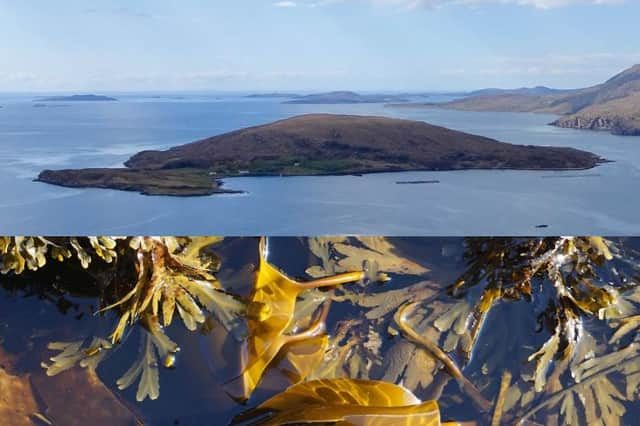Blistering bladderwrack! It’s Scotland’s first seaweed festival


For most recreational water users, seaweed is something that gets in the way. For surfers, if it’s not causing you to slip up as you pick your way carefully over low-tide rocks, it’s getting tangled around your leash as you paddle out. In a sea kayak, too, seaweed is more of a hindrance than a help, either slowing you down or getting wrapped around your paddle or both. And for transatlantic sailors, record blooms of sargassum weed in recent years have created what is now in effect an enormous, floating yacht trap, dubbed the Great Atlantic Sargassum Belt.
A new festival taking place near Ullapool next month, however, invites us to reimagine seaweed as “extraordinary yet often overlooked wonder of our marine environment,” so perhaps we should give it a second chance.
Advertisement
Hide AdAdvertisement
Hide AdRunning from 6-12 September, the all-new Isle Martin Seaweed Festival, focused on and around the community-owned Isle Martin in the north-west Highlands, just at the mouth of Loch Broom, is supported by EventScotland as part of the Year of Coasts and Waters 20/21.
Originally slated to run last year, but postponed due to the pandemic, the festival will feature a mixture of in-person events both on and off the island, and an online programme, which will allow seaweed fans and the seaweed-curious to take part from all around the world.
Highlights include a chance to taste different kinds of seaweed with forager and cook Jayson Byles, an exhibition of seaweed-related art in the gallery windows of Ullapool’s visual arts centre, An Talla Solais, and a seaweed-themed film night at the Ullapool ferry terminal.
Various guest speakers will make the case for the ecological importance of seaweed – marine biologist Ailsa McLellan, ecologist John McIntyre and Professor Juliet Brodie, resident seaweed sage at the Natural History Museum in London – and the historical and cultural importance of seaweed will be considered too, notably by the academic and long-distance kayaker David Gange, who will paddle his sea kayak over to Isle Martin to share his thoughts on “Seaweed at the Centre of the World.”
Gange is a lecturer in history at the University of Birmingham and also the author of the excellent 2019 book The Frayed Atlantic Edge. In it, he recounts an extraordinary paddle along the west coast of the British Isles, all the way from Shetland to Cornwall, which he uses as a jumping off point for a major reimagining of the history of our archipelago, casting the coastline not as peripheral to the main narrative but absolutely central.
The now-defunct kelp industry is a recurring theme in the book, and in one memorable passage Gange recounts how in Orkney, at the height of the kelp boom of the late 18th and early 19th centuries, “whole families helped build huge piles for burning” and “Westray and Papay were as alive with the smoke and fire of industry as Manchester and Coalbrookdale.”
When burned into ash, seaweed provides alkali that can be used for making soap and glass, and by the early 19th century an estimated 60,000 people were working in kelp manufacture in Scotland. When the Industrial Revolution is taught in schools, it is usually with reference to “dark satanic mills” situated inland, but as Gange points out, the revolution was also taking place along Scotland’s coastline.
Also appearing at the festival (and also a sea kayaker – she’s even built her own wooden kayak) is the Dutch artist, poet and novelist Miek Zwamborn, who is currently based near Fionnphort on the Isle of Mull. Her lavishly illustrated Seaweed Collector’s Handbook, published earlier this year, covers the history, culture and uses of seaweed, ”from the Neolithic people of the Orkney Islands to sushi artisans in modern Japan.” It also contains insights into the significance of seaweed in Japanese poetry, where it often denotes prosperity, and in the Japanese art of the 18th and 19th centuries, where it crops up in valuable, limited edition woodcut prints called surimonos, which frequently incorporated poems.
Advertisement
Hide AdAdvertisement
Hide AdYou might think that, by programming both Gange and Zwamborn in the same year, the organisers of the Seaweed Festival would have left themselves struggling to find any more seaweed-savvy authors for their second edition. Once you start looking, though, the literary algologists are everywhere.
In 2017, the author and journalist Annalena McAfee wrote a wide-ranging and very personal essay on seaweed for the New York Times, taking in, among other things, memories of her aunt Annalena feeding her dried seaweed in Glasgow in the 1960s, and the Victorian seaweed craze that saw everyone from George Eliot to the monarch herself hitching up their petticoats and collecting samples of “ocean flowers.” And then, of course, there’s Kathleen Jamie, whose poem “The Glass-Hulled Boat” contains a wonderfully vivid evocation of looking down from the titular vessel at underwater high-rises of bladderwrack “swaying sideways and back / like half-forgotten ancestors.” Perhaps they could form a double-act for the festival’s 2022 edition.
The Isle Martin Seaweed Festival, 6-12 September, www.islemartin.org/isle-martin-seaweed-festival-home/
A message from the Editor:
Thank you for reading this article. We're more reliant on your support than ever as the shift in consumer habits brought about by coronavirus impacts our advertisers.
If you haven't already, please consider supporting our trusted, fact-checked journalism by taking out a digital subscription at https://www.scotsman.com/subscriptions